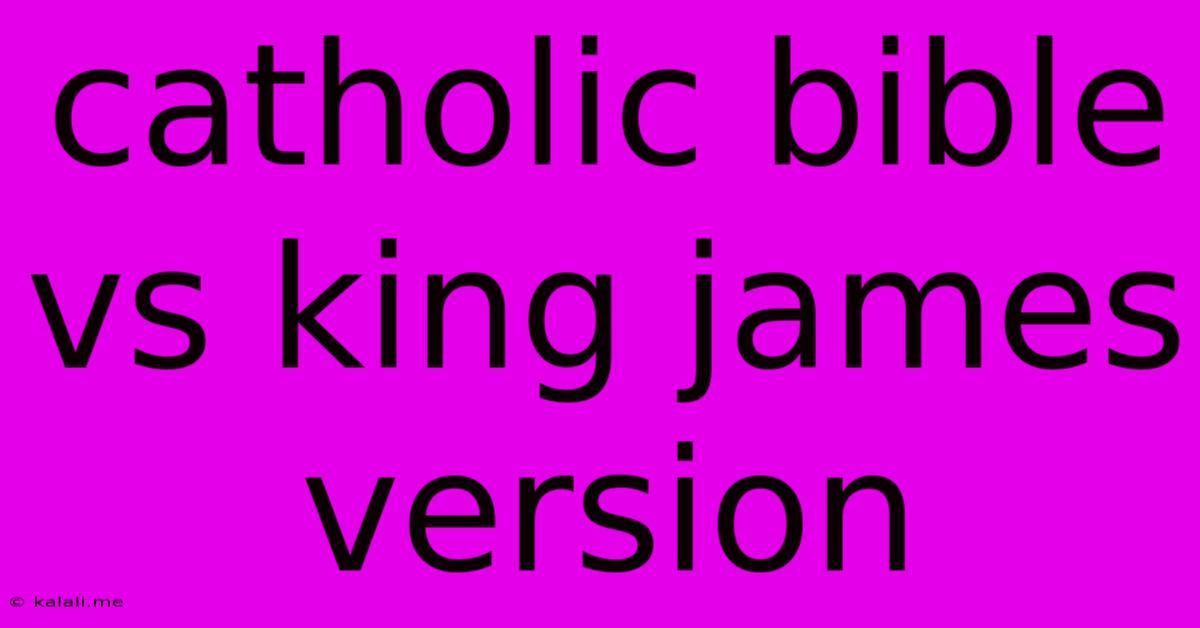Catholic Bible Vs King James Version
Kalali
Jun 04, 2025 · 3 min read

Table of Contents
Catholic Bible vs. King James Version: Understanding the Differences
The Bible is the foundation of Christianity, but its various versions can sometimes be confusing, especially for those unfamiliar with the nuances of biblical translation. Two prominent versions, the Catholic Bible and the King James Version (KJV), often spark discussion due to their differences in content and translation philosophy. This article delves into the key distinctions between these two influential translations, clarifying their origins and highlighting the implications for readers. Understanding these differences allows for a more informed and nuanced engagement with scripture.
The Origin and History: Two Distinct Paths
The Catholic Bible, also known as the Vulgate Bible (after its Latin translation), has a long and complex history. Its development spans centuries, rooted in early Church traditions and culminating in St. Jerome’s 4th-century translation from Hebrew, Aramaic, and Greek texts. This version includes the deuterocanonical books (also called the Apocrypha), which are considered canonical scripture in the Catholic Church, but not in most Protestant traditions. These books, such as Tobit, Judith, and Wisdom, offer additional historical and theological context.
The King James Version (KJV), on the other hand, emerged much later in 1611. Commissioned by King James I of England, it aimed to provide a single, authoritative English translation of the Bible, unifying the various English translations that existed at the time. The KJV is largely based on the Masoretic Text for the Old Testament and Greek texts for the New Testament, but it notably omits the deuterocanonical books included in the Catholic Bible.
Key Differences: Content and Translation Philosophy
The most significant difference lies in the inclusion of the deuterocanonical books. This results in a considerably larger Catholic Bible compared to the KJV. These additional books offer expanded narratives and perspectives on key theological themes, leading to a broader and potentially richer understanding of biblical history and teachings for Catholic readers.
Beyond the inclusion of books, the translation philosophy also plays a crucial role. The KJV is known for its archaic language and poetic style, which some find beautiful and evocative, while others find it challenging to understand. The language often uses words and sentence structures that have evolved over the centuries, leading to potential ambiguities in interpretation. More modern translations of the Bible, both Catholic and Protestant, aim for greater clarity and accessibility. While many modern Catholic translations retain the deuterocanonical books, they typically employ more contemporary language for easier understanding.
Different interpretations might arise from the various underlying texts used by the translators. Although the KJV and Catholic Bibles generally agree on core teachings, subtle variations in word choices and sentence structure can, at times, lead to differing interpretations of specific passages.
Implications for Readers: Choosing the Right Version
The choice between the Catholic Bible and the KJV (or any other translation) depends on individual needs and preferences. For Catholics, using a Bible that includes the deuterocanonical books is essential for aligning with their church’s official canon. The KJV, while historically significant, might present challenges in terms of language and the absence of these books.
For Protestant readers, the KJV has historical significance and a literary beauty, but the absence of the deuterocanonical books reflects their denominational understanding of scripture. Modern translations are readily available and offer increased clarity. Ultimately, selecting a translation should consider the reader’s theological background, understanding of biblical languages, and personal preferences. Considering the purpose—study, devotional reading, or liturgical use—will help in making an informed decision.
Conclusion: A Rich Tapestry of Scripture
The Catholic Bible and the King James Version represent distinct approaches to translating and interpreting the Bible. Understanding their origins, content variations, and differing translation philosophies enables a deeper appreciation of the rich tapestry of scripture and provides valuable context for theological discussions. The key is to choose a translation that best serves your needs and allows for a meaningful engagement with God’s word. Further research into specific translations and their respective merits is encouraged for a well-rounded understanding.
Latest Posts
Latest Posts
-
Cinema 4d Get An Object To Bend Around A Cirlce
Jun 06, 2025
-
Generalized Multiple Linear Regression Chi Square
Jun 06, 2025
-
No Http Resource Was Found That Matches The Request Uri
Jun 06, 2025
-
How Do I Send A Imessage As A Text Message
Jun 06, 2025
-
Pandas Hvplot Set Plot Defaults Font Size
Jun 06, 2025
Related Post
Thank you for visiting our website which covers about Catholic Bible Vs King James Version . We hope the information provided has been useful to you. Feel free to contact us if you have any questions or need further assistance. See you next time and don't miss to bookmark.